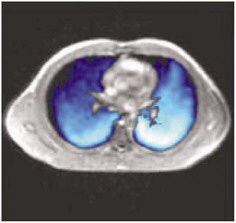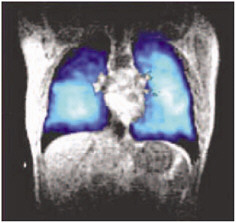AMO Science Impacting the Economy
Whether hiking in the mountains with the aid of a handheld Global Positioning System (GPS) navigational device, surfing the Internet, listening to a CD player, or simply using the telephone, we are today surrounded by technology that in some way has benefited from the investment in AMO science and its resultant application. Whole industries, including those producing consumer electronics, media and communications companies, health care companies, and defense system contractors, have become multibillion-dollar contributors to the economy of the United States.
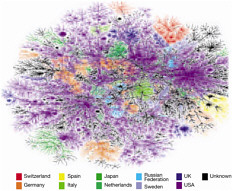
FIGURE 1 Each line on the map represents a path that e-mail might take through the global Internet. The colors indicate different geographical locations. Internet routers are located at each branch.
Much of the growth in the communications industry during the last 20 years was based on a revolution in optical communications that made the global Internet a reality today (Figure 1). Indeed, the Internet is based on an explosion of new technologies like diode lasers, the extremely bright light sources no larger than a grain of salt that send trillions of light pulses each second through optical fiber networks. The entire network is made transparent by compensating for optical absorption in the fibers with amplifiers that boost the light signals every 50 miles. Fiber amplifiers increase the range of optical communications, enabling transcontinental and global communications links. These amplifiers also allow hundreds of different-colored laser beams to be transmitted simultaneously on the same optical fiber using a single optical amplifier. At the present data rates, these optical networks can transmit the information content of the Library of Congress between New York and London in less than a second on a single optical fiber. So many optical fibers have been installed that, if placed end to end to form a single fiber, they could encircle the globe several times over. Internet optical backbone link capacity increased a hundredfold between 1995 and 1998, to 20,000 trillion bits per second. While the communications industry has recently suffered a downturn, the potential for increasing demand for capacity in the 21st century remains, with
features and services such as HDTV, broadband communications, and advanced home security systems becoming more available through the use of optical fiber, wireless, satellite, and cable connections.
Paired with the growth in communications has been the growth of computers and information processing. The GPS receivers and wireless phones available today use the latest in integrated circuit technology. AMO science is playing a key role by enabling the increase in the density and speed of computer chips. As an example of what is possible even today, a tiny transistor component on a chip is shown in the electron microscope image in the box “Laser Lithography.” This transistor would easily fit inside a bacterial cell.
Computer technology continues to advance, resulting in everfaster computation speeds. This progress is based on the decreasing size of the transistors in the very-large-scale integrated (VLSI) circuits used in computers and signal processors. Transistor feature sizes in commercial production have been decreasing, from 0.35 microns in 1995 to 0.13 microns in 2002. These dimensions are nearly 1/1,000th the diameter of a single strand of human hair. One important factor limiting feature size on a chip, and thus the computational speed, is the wavelength of the light used to form the transistor patterns and interconnecting wires. The shorter the wavelength, the smaller the features.
|
LASER LITHOGRAPHY 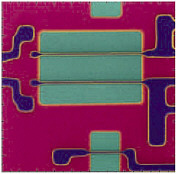 A top-down scanning electron microscopic view of a field-effect transistor gate (green rectangle) where the source and drain for the device (narrow blue horizontal lines) are spaced by only 0.12 microns (a human hair is approximately 100 microns wide). These ultrasmall features are patterned by photolithography. Photolithography uses a patterned mask in combination with an excimer laser with a wavelength of 248 or 193 nanometers. The beam from the laser is focused through the mask to expose the features seen above. This transistor is a component in a digital signal processor fabricated at Bell Labs. It operates at 100 megahertz and uses only a 1-volt power supply. Potential applications include enabling smaller and lighter cellular phones with extended battery life. The technology also could be instrumental in data transport over wireless phones, in higher-speed Web surfing, and in video applications. |
Today, ultraviolet excimer lasers with average output powers in the 20-watt range are replacing the older mercury arc sources. It is interesting to note that it would take more than a billion 100-watt incandescent lightbulbs on at the same time to be effectively as bright as this laser source. Excimer lasers operate using the light emitted from gas molecules excited in an
electric discharge. Their operation, and future advances, all depend on AMO science.
Plasma processing is used to etch many of the small features of a state-of-the-art transistor. Atoms and molecules interact with one another and with the surface of the semiconductor circuit during this processing to form or deposit the circuit components and features. The speed at which this process can take place and its uniformity over the large wafers used for making silicon VLSI circuits rely critically on our understanding of the collision and excitation dynamics of the atoms and molecules in the plasma processing environment. AMO science is now at the point of being able to predict and model these important processes in great detail. Designing future processing systems that extend the etching and deposition to ever-finer dimensions with higher aspect ratios, greater processing speeds, lower production costs, and increased uniformity will rely heavily on the insights that we are developing through these models.
The dimensions of individual transistors on computer chips are shrinking to the level of the dimensions of single atoms and molecules. For example, there are presently only a few molecules of silica glass separating the active gating structures in transistors. If the present decrease in the dimensions of transistors is to continue, transistors will have to be no bigger than a single molecule by the year 2020. At this scale, quantum mechanical processes become very important. Even the methods of computation may evolve, with quantum processing of information resulting in stunning new computing capabilities. These eagerly anticipated advances will certainly rely on advances in AMO science.
|
OPTICAL STORAGE Music, data, and computer software information are often stored on CDs or DVDs. How do these information storage disks work? The key component is a tiny semiconductor diode laser that is focused to a microscopic spot on the disk as the disk rapidly rotates on the disk platter. The laser is mounted on a mobile arm so that it can track a spiral line of dimples that winds its way around the disk. A scanning probe microscope picture of these dimples is shown below for a DVD.  Each dimple on the disk is only 0.5 microns wide (a human hair is approximately 100 microns wide). The laser is tightly focused so that it reflects from only one line of dimples at a time. Laser light can be focused to a spot that is nearly equal in size to the laser’s wavelength. Light wavelengths vary from 1 micron in the deep red to 0.35 microns in the violet end of the rainbow. The bluer the light, the more densely the information on the disk can be packed. DVDs use both 0.65- and 0.63-micron wavelengths (red light) and contain 4.7 billion bytes of information, nearly eight times the information on a CD. |
The precise control afforded by the laser has other important applications. Laser drilling can form holes smaller than the diameter of a human hair while precisely positioning them to an even better accuracy. So it becomes conceivable to construct cars from material that is cut using high-power lasers based on light emitted from carbon dioxide molecules. These lasers emit intense beams that can be
focused extremely accurately to make precision cuts with very little waste. A laser cutting a sheet of metal is shown at the beginning of this chapter, on page 6. Clothing, too, may be cut using a laser.
Compact disk (CD) players read the billions of bits of information stored on a CD with a tiny laser that costs less than a dollar. This semiconductor diode laser emits dark red light with a wavelength of 0.78 microns. The laser is focused to a microscopic point, where it is reflected from the bits of information that are stored as dimples on the CD. The newer digital versatile disks (DVDs) can store and read nearly eight times as much information as a CD by using shorter wavelength lasers that emit at wavelengths of 0.65 and 0.63 microns (see box “Optical Storage”). Another increase in information density is expected with the advent of even shorter wavelength lasers that emit light in the blue and violet. Diode lasers are also used in laser printers and commercial printing applications.
Anyone flying across North America at night will see from 35,000 feet a vast array of lights extending from coast to coast, as shown in the satellite photograph that is Figure 2. This lighting consumes nearly 20 percent of the total power generated across the nation. AMO science is making an important contribution to the quality and efficiency of lighting by studying the emission of light from the collision of electrons and atoms in electrical discharge lamps. At present, discharge plasma light sources—including low-pressure fluorescent lamps and high-pressure, metal-halide, high-intensity-discharge lamps—yield both good color and efficiencies that are nearly five times greater than those of common incandescent lights. There is good hope that lighting scientists will be able to increase this efficiency another two- or threefold while improving the color of the light emitted to suit a variety of applications. Research progress has been excellent in the field because of much better electron-atom collision and spectroscopic data, combined with an increase in computational power, leading to the development of more accurate lighting models. In the end, more efficient lighting will help conserve fossil fuels, reduce environmental problems, and provide significant savings to the economy.

FIGURE 2 Satellite view of lighting across the United States at night.
The theme of precision measurements based on atomic, molecular, and optical science has had a dramatic impact on all our lives. Perhaps the most impressive example is the Global Positioning System (GPS), a system of 24 satellites that surround Earth and send radio messages to receivers on the ground (Figure 3). Each satellite has an ultraprecise atomic clock onboard that keeps time to an accuracy corresponding to the loss or gain of no more than a second since the time of the dinosaurs, nearly 140 million years ago. This incredible accuracy is obtained by monitoring the fundamental rhythms that beat within each isolated atom.
The need to reckon time is deeply embedded within the human psyche. The history of clocks began with Neolithic bone carvings that marked the passing of seasons. Then, in the last few
centuries, the precision of clocks improved, from seconds per day to seconds per decade. In the first half of the 20th century, crystal-controlled electric clocks were developed for communication and navigation. In the second half of the 20th century, there was an unprecedented advance in timekeeping—the precision jumped by a factor close to one million. One motivation for this spectacular increase was to satisfy curiosity about one of the most profound of all theories: Einstein’s theory of gravity. The aim was to make a clock precise enough to reveal how time is altered by gravity—the geometrical shape of space and time. The result was the invention of the atomic clock, which has enabled the GPS system.
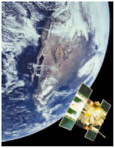
FIGURE 3 GPS satellite orbiting Earth and transmitting atomic clock information.
The GPS is a useful tool for a wide range of people, including sportsmen, farmers, soldiers, pilots, surveyors, delivery drivers, sailors, dispatchers, lumberjacks, and firefighters. GPS makes their work and leisure safer and more efficient (Figure 4).
There are many ways in which atomic, molecular, and optical science has profoundly contributed to our economy and way of life. The advances described here give only a conservative glimpse of what may happen in the coming few years. What will the future bring? The possibilities opened up by the Internet seem limitless. Computational speeds and information storage will almost certainly continue to increase, requiring entirely new technology to be developed at the atomic and molecular level. Improvements in the GPS should make it possible to resolve positions no further apart than the width of your finger, making such applications as self-guided cars possible.
The benefits that society will reap in the future depend on the investments it makes in the present. For example, a significant increase in demand for capacity in the global optical communications network could sooner or later strain the capabilities of low-loss optical fiber and semiconductor laser transmitters to their limits. What, then, will be the next breakthrough in this technology? It will be an exciting adventure, one that is vital to our society, to explore new high-speed optical devices and optical networks or perhaps even an entirely new optical phenomenon that one day will play a central role in global communications.

FIGURE 4 A hiker in a remote area can use a handheld GPS receiver to access atomic clocks that give his position to an accuracy of a few yards.

